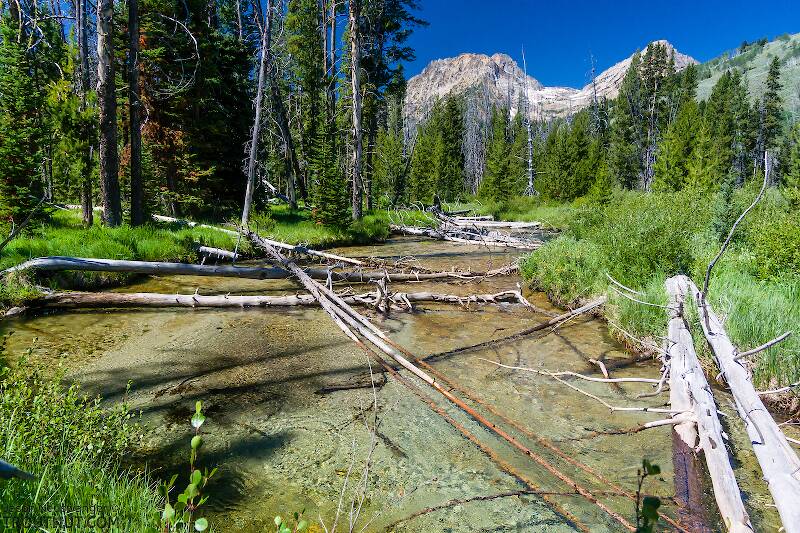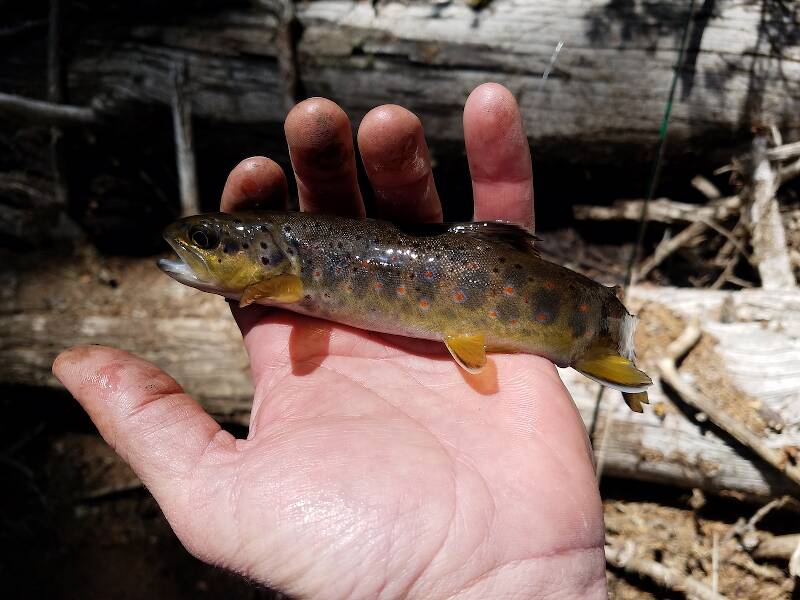
Blue-winged Olives
Baetis
Tiny Baetis mayflies are perhaps the most commonly encountered and imitated by anglers on all American trout streams due to their great abundance, widespread distribution, and trout-friendly emergence habits.
Featured on the forum

With a bit of help from the microscope, this specimen keys clearly and unsurprisingly to Hydropsyche.

Troutnut is a project started in 2003 by salmonid ecologist Jason "Troutnut" Neuswanger to help anglers and
fly tyers unabashedly embrace the entomological side of the sport. Learn more about Troutnut or
support the project for an enhanced experience here.
Scudmissle on Apr 20, 2020April 20th, 2020, 4:08 am EDT
I can't help but get the feeling that I'm fishing too often with flies that are too large. I started fly fishing about three years ago, and the first rod I bought was a 7wt, I'd heard 5's and 6's were good all rounders, but I had visions of trophy fish skating over my eyes. Likewise when I looked through the fly cases at the local fly shop I didn't even pause to look at midges or chironomids. I immediately bought a bunch of fancy looking streamers, bait fish style flies, huge terrestrials, attractors, poppers. With very little knowledge of what I even wanted to fish, and even less knowledge of how to select flies for different fishing scenarios, I reasoned, big fish like big snacks. Now I did end up catching some decent fish, top water bass and pike, one or two large brookies, and occasionally an over ambitious trout would bite off more than it could chew but my success rates were very low. It took me a while to realize that, for rivers I fished most often and their residents brook trout, I was way over gunned.
Now a few years later things have totally changed. My go to rod is a 4wt, and I have way more success with it when brook trout fishing. I discovered that there are perhaps a few myths out there about the size of your rod....
1. you can't catch a big fish on a light rod... In fact, after landing aggressive walleye over 15" on my 4wt, I realized that the weight of the rod has a lot more to do with how it handles the line, and the size of the flies, than it does with the size of the fish. Handled properly, my fast action 4wt rod has no problem fighting with those medium sized fish at all.
2. to catch a big fish you need big bait.... sure a little 6" brook trout is less likely to take a stab at your size 6 hook than an 18", but that doesn't mean that the 18" doesn't spend most of its day snacking on many of the same tiny morsels that the 6" does.
SO.. to the point. Although I've learned a lot since I started, and I fish smaller flies than I did before, I still find tying on flies with some doubt, is this too big?! The majority of my flies are in the 14-10 range, some 16's, some 8's... but nothing in 18's or 20's.
My question is this... when fishing for resident brook trout, what sizes are you most often fishing? Can someone speak with experience on selecting fly sizes? And also, can anyone speak with experience about larger fish taking small flies?
happy angling...
Now a few years later things have totally changed. My go to rod is a 4wt, and I have way more success with it when brook trout fishing. I discovered that there are perhaps a few myths out there about the size of your rod....
1. you can't catch a big fish on a light rod... In fact, after landing aggressive walleye over 15" on my 4wt, I realized that the weight of the rod has a lot more to do with how it handles the line, and the size of the flies, than it does with the size of the fish. Handled properly, my fast action 4wt rod has no problem fighting with those medium sized fish at all.
2. to catch a big fish you need big bait.... sure a little 6" brook trout is less likely to take a stab at your size 6 hook than an 18", but that doesn't mean that the 18" doesn't spend most of its day snacking on many of the same tiny morsels that the 6" does.
SO.. to the point. Although I've learned a lot since I started, and I fish smaller flies than I did before, I still find tying on flies with some doubt, is this too big?! The majority of my flies are in the 14-10 range, some 16's, some 8's... but nothing in 18's or 20's.
My question is this... when fishing for resident brook trout, what sizes are you most often fishing? Can someone speak with experience on selecting fly sizes? And also, can anyone speak with experience about larger fish taking small flies?
happy angling...
Wbranch on Apr 20, 2020April 20th, 2020, 11:38 am EDT
Hello Scudmissile,
I have to disagree with you on this comment. I have caught hundreds of 18" - 22" trout and a couple dozen 22" - 24" and probably at least 80% have been caught on #16 - #18 flies.
I think it all depends on where you are fishing. If you frequent systems rich in aquatic insect life with a more or less constant water temperature not subjected to seasonal flooding the fish are going to eat more aquatic insects than crayfish or forage fish.
to catch a big fish you need big bait.... sure a little 6" brook trout is less likely to take a stab at your size 6 hook than an 18", but that doesn't mean that the 18" doesn't spend most of its day snacking on many of the same tiny morsels that the 6" does.
I have to disagree with you on this comment. I have caught hundreds of 18" - 22" trout and a couple dozen 22" - 24" and probably at least 80% have been caught on #16 - #18 flies.
I think it all depends on where you are fishing. If you frequent systems rich in aquatic insect life with a more or less constant water temperature not subjected to seasonal flooding the fish are going to eat more aquatic insects than crayfish or forage fish.
Catskill fly fisher for fifty-five years.
Scudmissle on Apr 20, 2020April 20th, 2020, 12:09 pm EDT
yes I agree with you. that's why I listed it as a "myth" or common misbelief of a novice fisherman. what I'm hoping to learn is what range of sizes different anglers find most productive.
Jmd123 on Apr 20, 2020April 20th, 2020, 1:16 pm EDT
Caught on a #12 elkhair caddis, no B.S.:
http://www.troutnut.com/topic/9408/Smallmouth-And-a-new-personal-record#48281
Big fish will take small flies!!
Jonathon
http://www.troutnut.com/topic/9408/Smallmouth-And-a-new-personal-record#48281
Big fish will take small flies!!
Jonathon
No matter how big the one you just caught is, there's always a bigger one out there somewhere...
Wbranch on Apr 20, 2020April 20th, 2020, 3:39 pm EDT
Scudmissile,
I guess I should of read your post in it's entirety.
I guess I should of read your post in it's entirety.
Catskill fly fisher for fifty-five years.
Martinlf on Apr 20, 2020April 20th, 2020, 4:14 pm EDT
For resident brook trout in many of the small mountain streams in Pennsylvania, for me it would depend partly on the size of the trout, and partly on the size of their typical meal. Some of the fishers I most respect use the largest flies the fish will take when fishing for small brook trout to avoid having the fish inhale them too deeply. In many local streams the native brookies are often 4-8" and a size 12 or 10 dry fly can sometimes be used. But if I were fishing in NE Canada and the brookies were big, I'd try to match the size of what's hatching, or for streamers, the size of the local minnows. Context is everything. Furthermore, if you are targeting other species in a variety of streams, you may find that in some a very small fly can be very effective. For years I would not fish a zebra midge. Then somebody gave me one, about a size 20, and I tried it. It worked on the brown trout in that spring creek. I started experimenting, and found that some bigger browns in the stream, perhaps due to pressure, perhaps because they ate a lot of midges, would take a small zebra midge before they'd take a larger fly at times. I kept downsizing, and so far my biggest fish / smallest zebra is a 19" brown that took about a size 24 zebra midge. I could hardly believe it, but I've had a number of browns over 14" take a very small zebra. I'll fish a size 24 or even a size 26 with confidence in some streams.
"He spread them a yard and a half. 'And every one that got away is this big.'"
--Fred Chappell
--Fred Chappell
Red_green_h on May 11, 2020May 11th, 2020, 11:46 am EDT
I caught a 18" rainbow off of a #16 black foam beetle on this little stocked pond on the edge of the Pecos Wilderness last August. The strike was one of the most violent I have ever had. The ensuing fight took a couple of the legs and bent the hook almost 90 degrees. I retired that fly on a little review mirror necklace.
Quick Reply
Related Discussions
Topic
Replies
Last Reply
0
May 4, 2007
by Bigguy250
by Bigguy250
1
Sep 14, 2010
by SlateDrake9
by SlateDrake9
7
Jun 25, 2019
by Wbranch
by Wbranch
Five days of warmwater flyfishing in southeastern Michigan - from Jonathon
In Fishing Reports by Jmd123
In Fishing Reports by Jmd123
0
Jul 22, 2009
by Jmd123
by Jmd123





